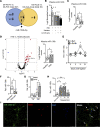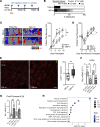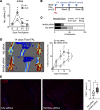Impaired angiogenesis in diabetic critical limb ischemia is mediated by a miR-130b/INHBA signaling axis
- PMID: 37097749
- PMCID: PMC10322685
- DOI: 10.1172/jci.insight.163041
Impaired angiogenesis in diabetic critical limb ischemia is mediated by a miR-130b/INHBA signaling axis
Abstract
Patients with peripheral artery disease (PAD) and diabetes compose a high-risk population for development of critical limb ischemia (CLI) and amputation, although the underlying mechanisms remain poorly understood. Comparison of dysregulated microRNAs from diabetic patients with PAD and diabetic mice with limb ischemia revealed the conserved microRNA, miR-130b-3p. In vitro angiogenic assays demonstrated that miR-130b rapidly promoted proliferation, migration, and sprouting in endothelial cells (ECs), whereas miR-130b inhibition exerted antiangiogenic effects. Local delivery of miR-130b mimics into ischemic muscles of diabetic mice (db/db) following femoral artery ligation (FAL) promoted revascularization by increasing angiogenesis and markedly improved limb necrosis and amputation. RNA-Seq and gene set enrichment analysis from miR-130b-overexpressing ECs revealed the BMP/TGF-β signaling pathway as one of the top dysregulated pathways. Accordingly, overlapping downregulated transcripts from RNA-Seq and miRNA prediction algorithms identified that miR-130b directly targeted and repressed the TGF-β superfamily member inhibin-β-A (INHBA). miR-130b overexpression or siRNA-mediated knockdown of INHBA induced IL-8 expression, a potent angiogenic chemokine. Lastly, ectopic delivery of silencer RNAs (siRNA) targeting Inhba in db/db ischemic muscles following FAL improved revascularization and limb necrosis, recapitulating the phenotype of miR-130b delivery. Taken together, a miR-130b/INHBA signaling axis may provide therapeutic targets for patients with PAD and diabetes at risk of developing CLI.
Keywords: Angiogenesis; Endothelial cells; Mouse models; Noncoding RNAs; Vascular Biology.
Figures







Similar articles
-
MicroRNA-375 repression of Kruppel-like factor 5 improves angiogenesis in diabetic critical limb ischemia.Angiogenesis. 2023 Feb;26(1):107-127. doi: 10.1007/s10456-022-09856-3. Epub 2022 Sep 8. Angiogenesis. 2023. PMID: 36074222
-
A miRNA/CXCR4 signaling axis impairs monopoiesis and angiogenesis in diabetic critical limb ischemia.JCI Insight. 2023 Apr 10;8(7):e163360. doi: 10.1172/jci.insight.163360. JCI Insight. 2023. PMID: 36821386 Free PMC article.
-
MicroRNA-24-3p Targets Notch and Other Vascular Morphogens to Regulate Post-ischemic Microvascular Responses in Limb Muscles.Int J Mol Sci. 2020 Mar 3;21(5):1733. doi: 10.3390/ijms21051733. Int J Mol Sci. 2020. PMID: 32138369 Free PMC article.
-
Noncoding RNAs in Critical Limb Ischemia.Arterioscler Thromb Vasc Biol. 2020 Mar;40(3):523-533. doi: 10.1161/ATVBAHA.119.312860. Epub 2020 Jan 2. Arterioscler Thromb Vasc Biol. 2020. PMID: 31893949 Free PMC article. Review.
-
Recent developments in targets for ischemic foot disease.Diabetes Metab Res Rev. 2024 Mar;40(3):e3703. doi: 10.1002/dmrr.3703. Epub 2023 Aug 10. Diabetes Metab Res Rev. 2024. PMID: 37563926 Review.
Cited by
-
Expression of mRNA for molecules that regulate angiogenesis, endothelial cell survival, and vascular permeability is altered in endothelial cells isolated from db/db mouse hearts.Histochem Cell Biol. 2024 Dec;162(6):523-539. doi: 10.1007/s00418-024-02327-4. Epub 2024 Sep 24. Histochem Cell Biol. 2024. PMID: 39317805 Free PMC article.
-
MicroRNAs in diabetic macroangiopathy.Cardiovasc Diabetol. 2024 Sep 16;23(1):344. doi: 10.1186/s12933-024-02405-w. Cardiovasc Diabetol. 2024. PMID: 39285459 Free PMC article. Review.
-
Endothelial ActRIIA inhibition protects the cardiac microvasculature in severe viral respiratory infection.Res Sq [Preprint]. 2025 Apr 1:rs.3.rs-6306417. doi: 10.21203/rs.3.rs-6306417/v1. Res Sq. 2025. PMID: 40235477 Free PMC article. Preprint.
-
A 6-Minute Limb Function Assessment for Therapeutic Testing in Experimental Peripheral Artery Disease Models.JACC Basic Transl Sci. 2024 Oct 23;10(1):88-103. doi: 10.1016/j.jacbts.2024.08.011. eCollection 2025 Jan. JACC Basic Transl Sci. 2024. PMID: 39906594 Free PMC article.
-
Synergistic effect of Hypoxic Conditioning and Cell-Tethering Colloidal Gels enhanced Productivity of MSC Paracrine Factors and Accelerated Vessel Regeneration.Adv Mater. 2025 Jan;37(3):e2408488. doi: 10.1002/adma.202408488. Epub 2024 Oct 9. Adv Mater. 2025. PMID: 39380372
References
-
- Hazarika S, et al. Impaired angiogenesis after hindlimb ischemia in type 2 diabetes mellitus: differential regulation of vascular endothelial growth factor receptor 1 and soluble vascular endothelial growth factor receptor 1. Circ Res. 2007;101(9):948–956. doi: 10.1161/CIRCRESAHA.107.160630. - DOI - PubMed
Publication types
MeSH terms
Substances
Grants and funding
LinkOut - more resources
Full Text Sources
Molecular Biology Databases
Research Materials
Miscellaneous

